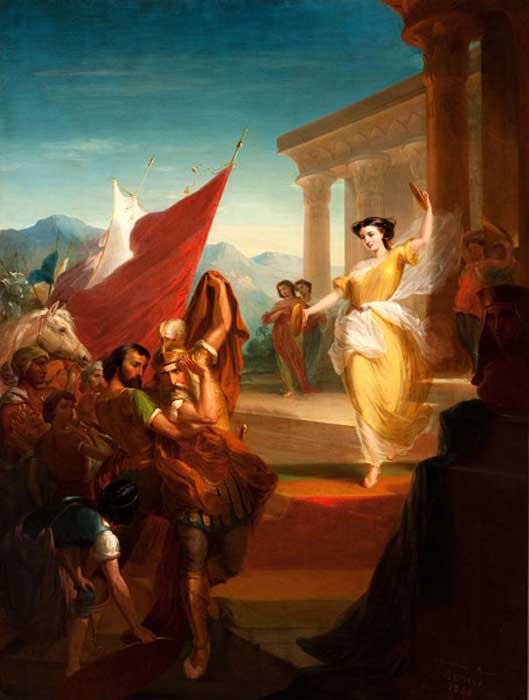
Throwing Virgins into the Sea and Other Ways to Appease the Gods: The Ancient Reasons behind Virgin Sacrifice
When the going got tough, it was believed sacrificing a virgin to the gods—by throwing them into the sea, burying them alive, or leaving them for hungry monsters—was the best plan.
Virgin sacrifice could be done for a number of widely accepted reasons: from winning a war, to appeasing an angry deity, or merely to protect architecture. For a time, the practice seemed to be widely recognized as many cultures show traces of virgin sacrifice in their mythologies and religious texts.

The Ancient Egyptians throwing a Virgin into the Nile, 1884 (Public Domain)
Gods are Listening: Hasty Promises You Shouldn’t Have Made
In Homeric legend, Iphigeneia was to be sacrificed by her father Agamemnon to appease Artemis so she would allow the Greeks to wage the Trojan War. An example of a virgin sacrifice is also mentioned in the Bible—the sacrifice of Jephthah’s daughter in Judges 11, in which Jephthah vows to sacrifice to God whatever or whoever comes to greet him at the door when he returns home if he is victorious. In the Book of Judges 11:31 in which Jephthah says, “whatever comes out of the door of my house to meet me when I return in triumph from the Ammonites will be the Lord's, and I will sacrifice it as a burnt offering." Unfortunately, when Jephthah returns from battle, it’s his virgin daughter who comes out of his door to greet him.

Jephthah’s Daughter (Public Domain)
In the 18th-century, French philosopher Voltaire noted the similarities between Jepththah and the Greek mythological general, Idomeneus, who asked the gods to calm a storm by promising that he would sacrifice the first living thing he saw upon his return. The first living thing turned out to be his young son.

The return of Idomeneus (Lena/CC BY 3.0)
According to Pliny the Elder, human sacrifice in Ancient Rome was abolished by a senatorial decree in 97 BCE, although by this time the practice had already become so rare that the decree was mostly a symbolic act.
The Vedic Purushamedha ("human sacrifice") was already a purely symbolic act in its earliest records. This was then followed by a period of embarrassment about violence in rituals of this sort as this period corresponds to the rise of Buddhism and Jainism, both of which place emphasis on ahimsa (“non-violence”). This period also corresponds to the composition of the Chandogya Upanishad (c. 8 - 6 BCE) which lists non-violence as a virtue.
The Japanese Yasiitomi-ki, a diary of the fifteenth century CE, contains an old tradition called Hitobashira ("human pillar") in which maidens were buried alive at the base or near some constructions to protect the buildings against disasters or enemy attacks. Of course, the question of why there would be any need to sacrifice a virgin at all is a rather difficult one to answer as we are only left with traces of this practice. However, the information we have may help us to understand the reason behind it.
Tame the Ocean and Save the Village: The Maiden & The Hero
Queen Cassiopeia was known as the beautiful wife of King Cepheus. One day, she boasted that her daughter, Andromeda, was far more beautiful than the fifty Nereids, sea nymphs, daughters of Nereus (the old man of the sea) and Doris. This boast angered Poseidon, who was married to Amphrite, the eldest of the Nereids. Poseidon had the sea monster, Cetus destroy the city where Andromeda lived with the king and queen. Cetus’ task was to wreak havoc in his pursuit and to not stop until the city was in shambles. The only way to stop Cetus was to sacrifice Andromeda to him. King Cepheus obeyed Poseidon and chained his daughter to a rock to save the land.
Like this Preview and want to read on? You can! JOIN US THERE ( with easy, instant access ) and see what you’re missing!! All Premium articles are available in full, with immediate access.
For the price of a cup of coffee, you get this and all the other great benefits at Ancient Origins Premium. And - each time you support AO Premium, you support independent thought and writing.
- Vestal Virgins: The Pious Maidens of Ancient Rome
- Lost in Translation? Understandings and Misunderstandings about the Ancient Practice of “Sacred Prostitution”
- Why Did Early Human Societies Practice Violent Human Sacrifice?
- 1,200-Year-Old Ceremonial Temple with Six Female Sacrifice Victims Unearthed in Peru
Martini Fisher is a Mythographer and author of many books, including “Time Maps: Australia, Early Sea Voyages and Invasions”. For regular updates about Martini’s books, interviews, courses, and blog, check out MartiniFisher.com
--
Top image: Sacrificial virgin on altar. (heywoody / Adobe)
















